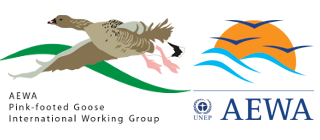Current Size: 76%
“Grubbing”: monitoring its impact on fragile arctic tundra
This August the latest efforts to monitor the impact of a rising pink-footed goose population on fragile arctic tundra in Svalbard were conducted by an international research team, led by Professor Jesper Madsen from Aarhus University.
The work is part of an on-going project to monitor and access the damage caused by pink-footed geese on arctic tundra vegetation and habitat structure. When the geese arrive on their breeding grounds in mid-May on Svalbard there is little growing vegetation. Various plant roots, however, provide nourishment and pink-footed geese dig for these. In this way whole plants can be destroyed. This so-called "grubbing" leads to areas of degraded vegetation which, when exposed to the elements, may eventually lead to completely vegetation-free areas. Detailed monitoring of the arctic tundra on Svalbard will continue for a number of years to determine the long term impact http://taminternational.com/cheap/ of grubbing by pink-footed geese. The project is funded by the Svalbard Environmental Fund and the first published report is expected in the spring of 2014.
Project participants: Jesper Madsen, Aarhus University, Denmark; Ingunn Tombre, NINA, Norway; James Speed, Trondheim University, Norway; Åshild Petersen, Norwegian Polar Institute, Svalbard and Rene van der Wal, Aberdeen University, UK.
Date added: 02.09.2013














